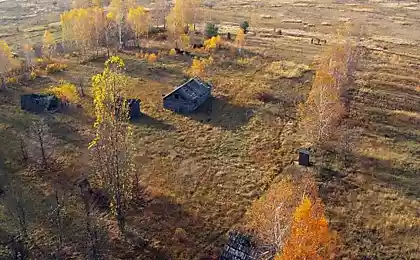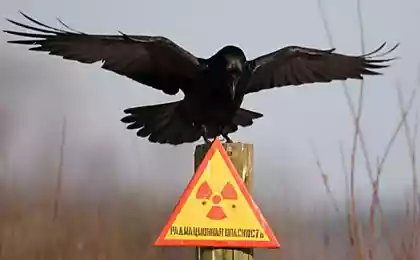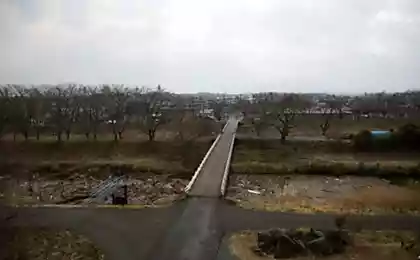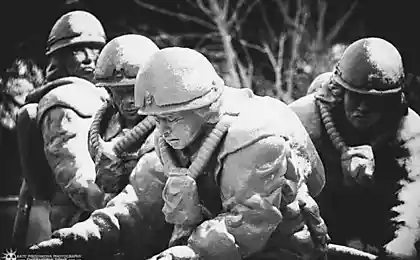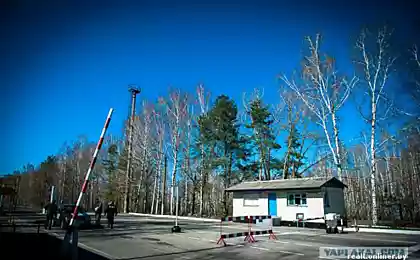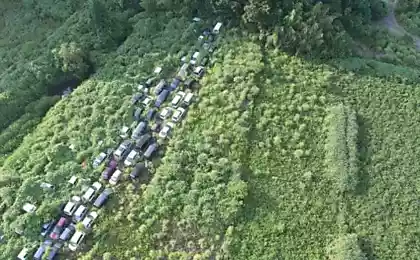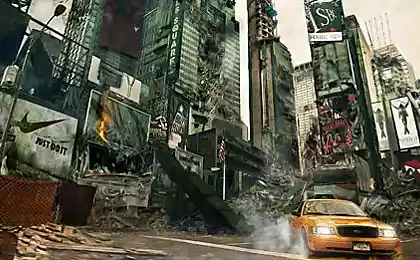1713
Land alienation
Writes shuvayev:
My colleagues and I have done a project of Kommersant about what living Chernobyl and its surroundings is 28 years after the accident - "Land alienation».
82 photos
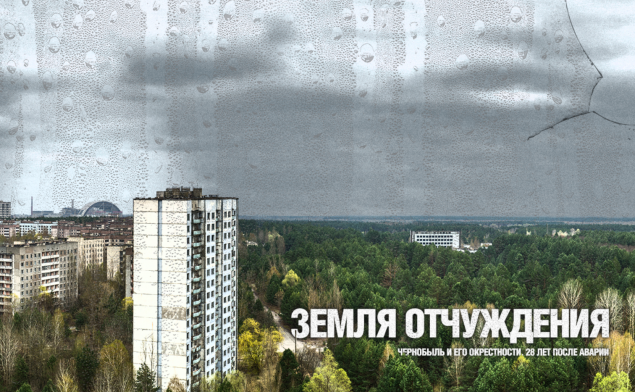
From Kiev to Chernobyl Exclusion Zone (CEZ), most of which is located in the Kiev region, a car can be reached within a couple of hours. On this site there are several villages and hamlets, and closer to the area - only forest. At the checkpoint "Dityatki" visitors are greeted by police officers, three red ginger cat and dog. Here a kind of border - from Checkpoint goes deep into the field fence with barbed wire. Policemen reconcile their passport data with lists sent by advance of the trip. Legally in the area can be accessed only local workers, relatives or self settlers strictly with the accompanying tourists. In 2009, Forbes magazine this place was included in the list of 12 most exotic tourist destinations par with Antarctica and North Korea. The radiation level in some places exceeds the allowable 30 times, but this does not stop wanting to look at the biggest monument to man-made disaster. Over the past ten years CEZ visited 40 th. Tourists. Flow increased significantly after the release in 2007 of the popular computer game «STALKER: Shadow of Chernobyl", action which takes place on the territories adjacent to the Chernobyl nuclear power plant. Since then, increasingly began to penetrate here illegally: Each year delay about 400 stalkers who are punished with a fine for an administrative violation in the 400 hryvnia (about 1, 2 thousand. Rub.).
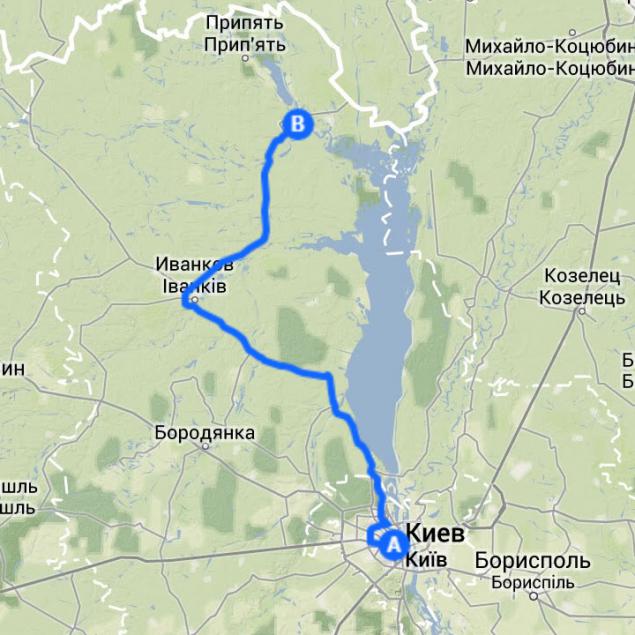
Subjected to as a result of the accident at the Chernobyl nuclear power plant radiation pollution territory of the Ukrainian SSR, Byelorussian SSR and the RSFSR were divided into four categories: the exclusion zone, resettlement zone, the zone of residence with the right to resettlement and living area with privileged socioeconomic status. To the exclusion zone includes areas of which in 1986 and 1987 is a compulsory evacuation. The total area of the Russian zone of alienation - 310 square meters. km, to the territories of other radiation hazard category includes another 11, 5 thousand sq. m. km.
In Russia, the exclusion zone is located in the Bryansk region, which housed four villages with a total population of 186 people.
In neighboring Belarus, this zone is much wider and includes an area where previously lived 22 thousand. People in 92 locations. In 1988, these contaminated areas was created Polesie State Radiation Ecological Reserve, where there is experimental apiary and garden, there are bred horses. Also in this area live bison population, lynx, Przewalski's horse.
In Ukraine, the exclusion zone (radius - 30 km) is located in Kiev and Zhitomir regions. The total area of the territory, where before the accident were 94 settlements with 116 thousand inhabitants. Is almost 2, 6 sq. M. km, slightly more than in Moscow. The length of the outer perimeter with barbed wire, checkpoints and dosimetric control points - about 440 km (about the distance between Moscow and Nizhny Novgorod). Inside CEZ isolated areas with special access mode - a ten-kilometer zone of the Chernobyl site and directly.
Chernobyl.
12 km to the Chernobyl

Today, Chernobyl - city, forever frozen in time of the Soviet Union. Small, with clean empty tree-lined streets, with inconspicuous gray two-story building, Chernobyl has been 28 years is half asleep. Prior to the accident at the Chernobyl nuclear power plant population here was about 13 thousand. Man, now - about 4 thousand. (Throughout CEZ - 5 thousand.). Occasionally you can meet a passerby, several times a day through the streets of the old Soviet bus passes for workers. Residential buildings here are a few - a couple dozen, mostly concentrated in the center. But the infrastructure of the city, despite the almost complete exclusion of the village, developed, although very slowly. The number of tourists here creates a demand and supply - the city is beginning to take a second life.
The building has an inactive bus and fire department stores are rural type, which sells mainly essentials (including alcohol in a wide range). They can even pay off credit cards and buy souvenirs: T-shirts with the inscription "Chernobyl", "apocalyptic" magnets with the image of Chernobyl and nuclear fungus and pink pens marked with radiation. The city opened a couple of hotels: one - in a converted old dormitory (small three-room quadruple-rooms), the second - in the house where they lived party officials (seven-bedded room in the renovated two-bedroom apartment). Works great Soviet dining room, and recently opened a cafe "Ten", which can be expensive to eat and sit at the bar with Wi-Fi. There is still a curfew, but local he seems bereft perceived as a formality.
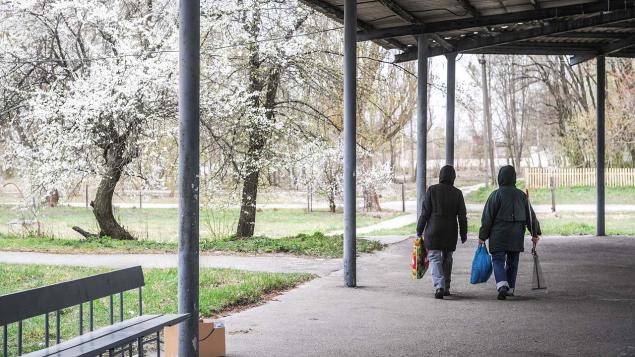
05
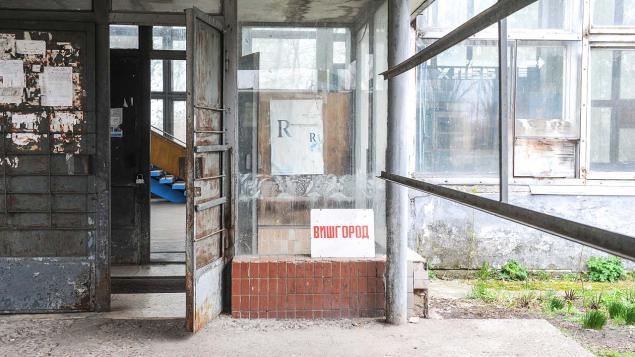
06

07

08 Angel Blowing

09

10
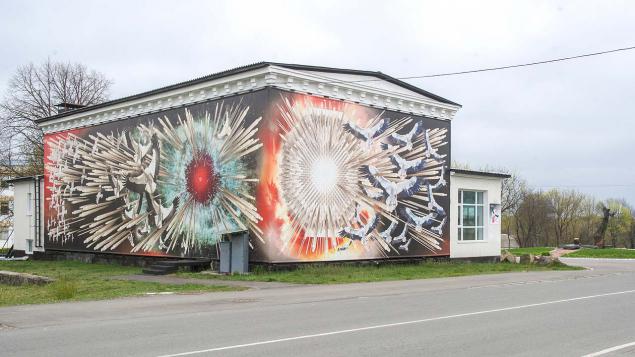
11
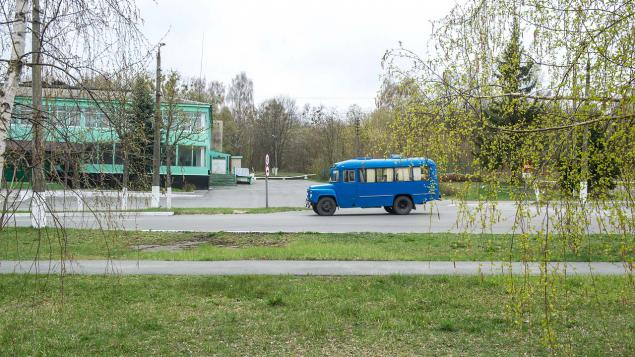
12
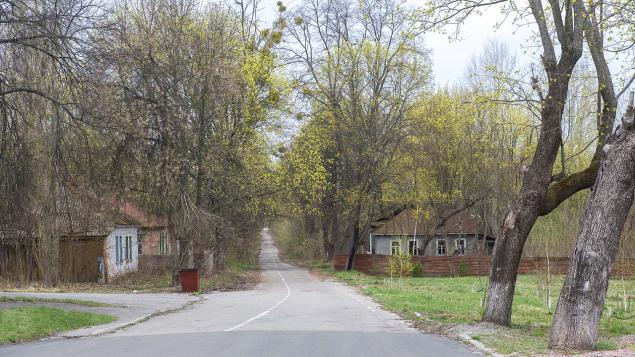
Living in Chernobyl mainly foresters, environmentalists, scientists, support personnel Chernobyl, and the Ukrainian Interior Ministry personnel guarding the 30-kilometer zone from the penetration of illegal immigrants. It was in Chernobyl are major undertakings engaged in the maintenance of the territory in an environmentally safe condition. They control the content of radionuclides in the water of the river Pripyat, its tributaries and the air. Work at Chernobyl in shifts - "4 for 3": Monday staff on buses delivered to the city, and on Thursday take away back to the "mainland". For some experts, a different schedule - "15 15" of two weeks in the area, the remaining two weeks at home. People go to work here from different regions of Ukraine, but most are from the Kiev region. 22-year-old Dasha from Vinnitsa region working in the Chernobyl cafe, because during the crisis could not get anywhere. Cook Dima, on the contrary, deliberately went to work here because of the high salaries by Ukrainian standards. Premium to basic earnings are given due to adverse working conditions. In the evening, "a dozen" local traditionally gather for dinner, watch TV and discuss the latest news - about events in eastern Ukraine and Crimea Evromaydane referendum.
Reactor
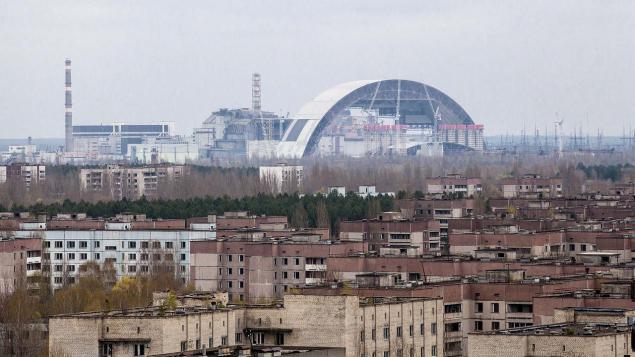
Chernobyl is considered the founding date of 1193, when this place was first mentioned in chronicles. With the formation in 1569 Rzeczpospolita city entered its composition. Later, in the XVIII century, it became one of the largest in Ukraine centers of Hasidism. In 1793, Chernobyl was annexed to the Russian Empire as a place Radomyshlsky County Kiev province, and later became a major transit point river. In 1921, Chernobyl became part of the Ukrainian Soviet Socialist Republic, and two years later - the center of the same district (received city status in 1941). Since 1990, this place attracted many pilgrims - religious Jews, develop graves buried in this land tzaddikim (righteous). Since 2001, the city hosts the only existing service in the Orthodox parish in the exclusion zone - St. Elias Church. The idea to use the "peaceful atom" in the service of the national economy of the USSR for the first time expressed Akademik Kurchatov - the creator of the Soviet atomic bomb. In the 70s of the last century in the Soviet Union began active construction of nuclear power plants, and within ten years the share of nuclear power plants accounted for 15% of all electricity generated in the country. The Chernobyl nuclear power plant was the pride of the Soviet Union: in 1986 it was the most powerful in the country and one of the world's most powerful nuclear power plants. USSR equated their successes in the nuclear industry to success in space exploration. The fact that the future of energy for nuclear power plants, no one doubted.
Chernobyl construction began in March 1970. The station was the third in the USSR with grafitovodnymi RBMK-1000 after the Leningrad (commissioned in 1973) and Kursk (1976) nuclear power plant. Chernobyl belonged to the single-loop type NPP supplied to the turbine steam formed directly in the reactor at boiling coolant passing through it (the water). A total of Chernobyl in 1978-1984 years have commissioned four units. Construction of the third stage (the fifth and sixth power units) was stopped in 1987. At the time of the accident the power plant produced 150 2 billion kW • h of electricity, and for the subsequent time to complete the decommissioning of December 15, 2000 - another 158, 6 billion kW • h. By 2000, worked at the station 9, 5 thousand. Man.
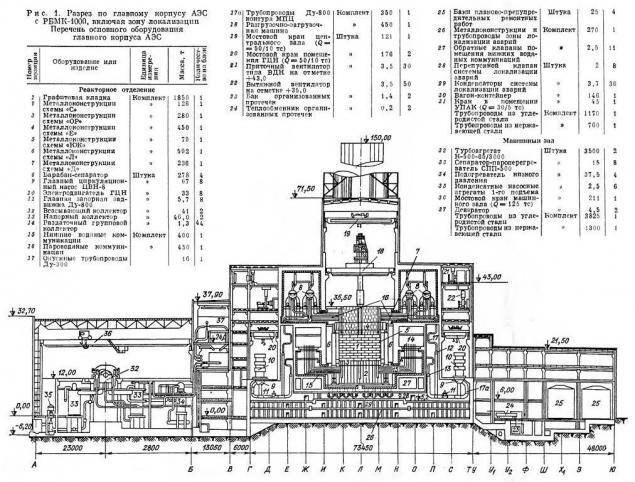
Currently the world's 11 reactors operated so-called Chernobyl-type (RBMK-1000), all on the Russian NPP Kursk, Leningrad and Smolensk. Another nuclear power plants with such reactors, Ignalina in Lithuania is not currently in use. A reactor of this type is not completed at Kursk NPP and, most likely, will never be put into operation. After the accident at the Chernobyl nuclear power plant fourth power in 1986 there were two serious incidents at stations equipped with RBMK-1000. In 1991 there was a fire in the engine room of the second block of the Chernobyl nuclear power plant in 1992 - the fuel channel gap at the Leningrad nuclear power plant. The victims were not.
How has the accident
April 25, 1986, 1:06 (hereinafter local time). The Chernobyl scheduled maintenance stop started the fourth power, during which it was planned to conduct the experiment. He was supposed to show whether the mechanical inertia of the rotor turbine generator used to generate electricity short by the sudden shutdown of the reactor.
April 26, 0:05. Achieved the planned experiment power level of the reactor is 700 MW, but power continued to decline, falling to half an hour to 30 MW. At this level require the immediate shutdown of the reactor, but the operator took braking reaction rods from the reactor, trying to regain power.
1:23. The experiment began at an unacceptably low power of 200 MW. After a few seconds the reactor power increased sharply by 100 times. The operator pressed the emergency button, which was supposed to shut down the reactor.

1:24. There was a first thermal explosion vybivshy top of the reactor - slab weighing 1 thousand. Tons. A few seconds later a second explosion completely destroyed the reactor, air emissions of 190 tons of radioactive substances, including isotopes of uranium, plutonium, iodine and cesium. Killed two members of the station, there was more than 30 fires.
1:28. Special fire department for the protection of Chernobyl (FH-2), we get a signal fire started quenching Chernobyl. Auxiliary fire guards also went to the station. Fire fighting lasted five hours were involved 15 fire brigades from Pripyat, Kiev, and the surrounding area. Rescuers did not have adequate protection.
11:00. Director Victor Chernobyl Bruchanov reported second secretary of the Kyiv oblast committee of the explosion and fire, lied that the radiation situation in the city of Pripyat and the nuclear danger is not.
20:20. At the crash came a government commission headed by the deputy chairman of the USSR Council of Ministers Boris Shcherbina.
22:00. Ministry of Health of the USSR adopted a decision on the necessity of emergency evacuation of Pripyat.
April 27 at 13:00. Pripyat Broadcasting Network reported on the collection and the temporary evacuation of residents. 50 thousand. People were removed from the city almost without things they were confident that will soon return. Helicopters began to fill the destroyed reactor absorbing materials, including boron carbide.
April 28. Announcer program "Time" read the first official TASS: "At the Chernobyl nuclear power plant accident occurred. One of the reactors was damaged. Measures are being taken to eliminate the consequences of the incident. Necessary assistance to victims. A government commission to investigate the incident. " Ministry of Foreign Affairs held a press conference, told foreign journalists about the disaster.
May 1st. In Kiev, where radiation levels exceed permissible limits, there were mass celebrations to mark May Day.
On 2 May. The evacuation of the population from the first 10-kilometer zone, and two days later - of the 30-kilometer zone.
May 8th. Began large-scale decontamination work for which people and equipment was thrown from across the CCCR.
May 14. Mikhail Gorbachev appeared on national television with an official statement about the accident.
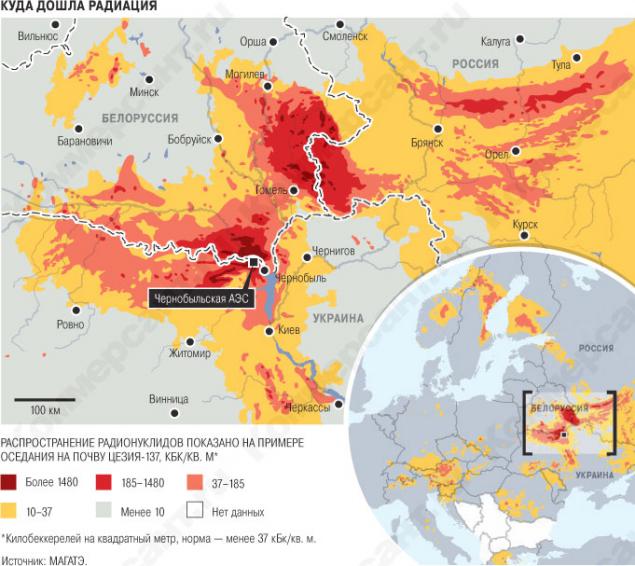
Immediately after the reactor explosion killed 31 people - employees of the station and fire. Most plant workers died within three months of receiving irradiation at doses of more than 4 thousand. MSv (lethal dose). The number of those who died later from radiation-induced cancer, is still unknown and remains a subject of debate. 530 thousand. People received doses of 10 to 1 thousand. MSv. These were people who were long-term in the affected area: the soldiers, rescue workers, technicians and employees of the plant. According to statistics, the most conservative of the Chernobyl Forum, 9 thousand. People died and about 200 thousand. People suffer from diseases caused by Chernobyl. According to the Ukrainian Ministry of Health from 2005 to 1987 and 2004 numbers only Ukrainians who died in the aftermath of the accident, has reached 530 thousand. Man. In 1991 a law was passed on the social protection of citizens affected by the disaster. There are currently about 7 million people in Russia, Belarus and Ukraine have the status of Chernobyl.
Pond around Chernobyl - an artificial reservoir that was created for the reactor cooling station. And offers a huge number of fish. Workers from neighboring sites and tourists find themselves here, do not miss an opportunity to feed the two-meter soms.

Dealing with the consequences of the accident
The first event in the aftermath of the accident to the public was the iodine prophylaxis, which, however, was promptly carried out only in Pripyat - the day of the accident. April 27 from it the evacuation of the population and only in May - from 10- and 30-kilometer exclusion zone around Chernobyl. In the spring and summer of 1986 from 400 thousand. People living in areas of exclusion and territories "strict radiation control", evacuated 116 thousand., In later years moved another 270 thousand. Man.
In May 1986, launched special activities for decontamination of settlements and technology in the exclusion zone, which included sanitization of buildings and streets, removing topsoil and burying contaminated equipment.
Then specially organized management of construction №605 Ministry of Medium Machine Building beginning to build a sarcophagus around the damaged reactor ("Shelter"). By November 1986 the construction of the sarcophagus was completed. For its construction was used by more than 100 thousand. Cubic meters of concrete and 6, 8 thousand. Tons of steel. Inside the "Shelter" is up to 95% of the fuel in the reactor which was at the time of the accident.
The volume of radioactive materials - 185-200 tons of the total activity of 16 million curies. At the same time since 1986 examined no more than 60% of the "Shelter", the other rooms are not available due to dangerous radiation fields and because of the obstacles that have arisen as a result of the explosion and the collapse of internal floors.
In the original papers in the aftermath of the accident in 1986-1987 participated 350 thousand. Man, the total number of liquidators is estimated at 600 thousand. Man.
A total of 1986-1991, the USSR spent to eliminate accident $ 18 billion, 35% of this amount allocated for social assistance to victims, 17% was spent on resettlement. The station was finally decommissioned in 2000 alone.
On the need to transform the sarcophagus built to a more secure facility conceived back in 1989. Then the Institute of Atomic Energy Kurchatov put forward the concept of building a new structure over the existing "Shelter" for the complete isolation of the contents of the destroyed power from the external environment. In 1991, additional options were offered full filling, complete disassembly and pouring concrete sarcophagus. But at the end of the international competition transformation projects "Shelter" into an environmentally safe system of Ukraine in 1996 definitively refused to create the repository in place of the fourth power, despite the criticism of Russian specialists.
In 1998, with support from the European Bank for Reconstruction and Development (EBRD) and a group of international donors launched "Implementation Plan" Shelter "» (SIP - Shelter Implementation Plan), including the construction of the New Safe Confinement (NSC or "Shelter-2 ") and storage of spent nuclear fuel.
In 2004, a tender for the construction of the NSC, which is August 10, 2007 won the American engineering consortium Bechtel-Battelle Memorial, a contractor for the project was specially created joint venture Novarka (subcontractors - Italian, American and Turkish companies).
Pripyat.
20
21
22
23
24
25
26
27
28
29
30
33
34
35
36
37
38
39
41
43
44
45
Source: http: //
My colleagues and I have done a project of Kommersant about what living Chernobyl and its surroundings is 28 years after the accident - "Land alienation».
82 photos

From Kiev to Chernobyl Exclusion Zone (CEZ), most of which is located in the Kiev region, a car can be reached within a couple of hours. On this site there are several villages and hamlets, and closer to the area - only forest. At the checkpoint "Dityatki" visitors are greeted by police officers, three red ginger cat and dog. Here a kind of border - from Checkpoint goes deep into the field fence with barbed wire. Policemen reconcile their passport data with lists sent by advance of the trip. Legally in the area can be accessed only local workers, relatives or self settlers strictly with the accompanying tourists. In 2009, Forbes magazine this place was included in the list of 12 most exotic tourist destinations par with Antarctica and North Korea. The radiation level in some places exceeds the allowable 30 times, but this does not stop wanting to look at the biggest monument to man-made disaster. Over the past ten years CEZ visited 40 th. Tourists. Flow increased significantly after the release in 2007 of the popular computer game «STALKER: Shadow of Chernobyl", action which takes place on the territories adjacent to the Chernobyl nuclear power plant. Since then, increasingly began to penetrate here illegally: Each year delay about 400 stalkers who are punished with a fine for an administrative violation in the 400 hryvnia (about 1, 2 thousand. Rub.).

Subjected to as a result of the accident at the Chernobyl nuclear power plant radiation pollution territory of the Ukrainian SSR, Byelorussian SSR and the RSFSR were divided into four categories: the exclusion zone, resettlement zone, the zone of residence with the right to resettlement and living area with privileged socioeconomic status. To the exclusion zone includes areas of which in 1986 and 1987 is a compulsory evacuation. The total area of the Russian zone of alienation - 310 square meters. km, to the territories of other radiation hazard category includes another 11, 5 thousand sq. m. km.
In Russia, the exclusion zone is located in the Bryansk region, which housed four villages with a total population of 186 people.
In neighboring Belarus, this zone is much wider and includes an area where previously lived 22 thousand. People in 92 locations. In 1988, these contaminated areas was created Polesie State Radiation Ecological Reserve, where there is experimental apiary and garden, there are bred horses. Also in this area live bison population, lynx, Przewalski's horse.
In Ukraine, the exclusion zone (radius - 30 km) is located in Kiev and Zhitomir regions. The total area of the territory, where before the accident were 94 settlements with 116 thousand inhabitants. Is almost 2, 6 sq. M. km, slightly more than in Moscow. The length of the outer perimeter with barbed wire, checkpoints and dosimetric control points - about 440 km (about the distance between Moscow and Nizhny Novgorod). Inside CEZ isolated areas with special access mode - a ten-kilometer zone of the Chernobyl site and directly.
Chernobyl.
12 km to the Chernobyl

Today, Chernobyl - city, forever frozen in time of the Soviet Union. Small, with clean empty tree-lined streets, with inconspicuous gray two-story building, Chernobyl has been 28 years is half asleep. Prior to the accident at the Chernobyl nuclear power plant population here was about 13 thousand. Man, now - about 4 thousand. (Throughout CEZ - 5 thousand.). Occasionally you can meet a passerby, several times a day through the streets of the old Soviet bus passes for workers. Residential buildings here are a few - a couple dozen, mostly concentrated in the center. But the infrastructure of the city, despite the almost complete exclusion of the village, developed, although very slowly. The number of tourists here creates a demand and supply - the city is beginning to take a second life.
The building has an inactive bus and fire department stores are rural type, which sells mainly essentials (including alcohol in a wide range). They can even pay off credit cards and buy souvenirs: T-shirts with the inscription "Chernobyl", "apocalyptic" magnets with the image of Chernobyl and nuclear fungus and pink pens marked with radiation. The city opened a couple of hotels: one - in a converted old dormitory (small three-room quadruple-rooms), the second - in the house where they lived party officials (seven-bedded room in the renovated two-bedroom apartment). Works great Soviet dining room, and recently opened a cafe "Ten", which can be expensive to eat and sit at the bar with Wi-Fi. There is still a curfew, but local he seems bereft perceived as a formality.

05

06

07

08 Angel Blowing

09

10

11

12

Living in Chernobyl mainly foresters, environmentalists, scientists, support personnel Chernobyl, and the Ukrainian Interior Ministry personnel guarding the 30-kilometer zone from the penetration of illegal immigrants. It was in Chernobyl are major undertakings engaged in the maintenance of the territory in an environmentally safe condition. They control the content of radionuclides in the water of the river Pripyat, its tributaries and the air. Work at Chernobyl in shifts - "4 for 3": Monday staff on buses delivered to the city, and on Thursday take away back to the "mainland". For some experts, a different schedule - "15 15" of two weeks in the area, the remaining two weeks at home. People go to work here from different regions of Ukraine, but most are from the Kiev region. 22-year-old Dasha from Vinnitsa region working in the Chernobyl cafe, because during the crisis could not get anywhere. Cook Dima, on the contrary, deliberately went to work here because of the high salaries by Ukrainian standards. Premium to basic earnings are given due to adverse working conditions. In the evening, "a dozen" local traditionally gather for dinner, watch TV and discuss the latest news - about events in eastern Ukraine and Crimea Evromaydane referendum.
Reactor

Chernobyl is considered the founding date of 1193, when this place was first mentioned in chronicles. With the formation in 1569 Rzeczpospolita city entered its composition. Later, in the XVIII century, it became one of the largest in Ukraine centers of Hasidism. In 1793, Chernobyl was annexed to the Russian Empire as a place Radomyshlsky County Kiev province, and later became a major transit point river. In 1921, Chernobyl became part of the Ukrainian Soviet Socialist Republic, and two years later - the center of the same district (received city status in 1941). Since 1990, this place attracted many pilgrims - religious Jews, develop graves buried in this land tzaddikim (righteous). Since 2001, the city hosts the only existing service in the Orthodox parish in the exclusion zone - St. Elias Church. The idea to use the "peaceful atom" in the service of the national economy of the USSR for the first time expressed Akademik Kurchatov - the creator of the Soviet atomic bomb. In the 70s of the last century in the Soviet Union began active construction of nuclear power plants, and within ten years the share of nuclear power plants accounted for 15% of all electricity generated in the country. The Chernobyl nuclear power plant was the pride of the Soviet Union: in 1986 it was the most powerful in the country and one of the world's most powerful nuclear power plants. USSR equated their successes in the nuclear industry to success in space exploration. The fact that the future of energy for nuclear power plants, no one doubted.
Chernobyl construction began in March 1970. The station was the third in the USSR with grafitovodnymi RBMK-1000 after the Leningrad (commissioned in 1973) and Kursk (1976) nuclear power plant. Chernobyl belonged to the single-loop type NPP supplied to the turbine steam formed directly in the reactor at boiling coolant passing through it (the water). A total of Chernobyl in 1978-1984 years have commissioned four units. Construction of the third stage (the fifth and sixth power units) was stopped in 1987. At the time of the accident the power plant produced 150 2 billion kW • h of electricity, and for the subsequent time to complete the decommissioning of December 15, 2000 - another 158, 6 billion kW • h. By 2000, worked at the station 9, 5 thousand. Man.

Currently the world's 11 reactors operated so-called Chernobyl-type (RBMK-1000), all on the Russian NPP Kursk, Leningrad and Smolensk. Another nuclear power plants with such reactors, Ignalina in Lithuania is not currently in use. A reactor of this type is not completed at Kursk NPP and, most likely, will never be put into operation. After the accident at the Chernobyl nuclear power plant fourth power in 1986 there were two serious incidents at stations equipped with RBMK-1000. In 1991 there was a fire in the engine room of the second block of the Chernobyl nuclear power plant in 1992 - the fuel channel gap at the Leningrad nuclear power plant. The victims were not.
How has the accident
April 25, 1986, 1:06 (hereinafter local time). The Chernobyl scheduled maintenance stop started the fourth power, during which it was planned to conduct the experiment. He was supposed to show whether the mechanical inertia of the rotor turbine generator used to generate electricity short by the sudden shutdown of the reactor.
April 26, 0:05. Achieved the planned experiment power level of the reactor is 700 MW, but power continued to decline, falling to half an hour to 30 MW. At this level require the immediate shutdown of the reactor, but the operator took braking reaction rods from the reactor, trying to regain power.
1:23. The experiment began at an unacceptably low power of 200 MW. After a few seconds the reactor power increased sharply by 100 times. The operator pressed the emergency button, which was supposed to shut down the reactor.

1:24. There was a first thermal explosion vybivshy top of the reactor - slab weighing 1 thousand. Tons. A few seconds later a second explosion completely destroyed the reactor, air emissions of 190 tons of radioactive substances, including isotopes of uranium, plutonium, iodine and cesium. Killed two members of the station, there was more than 30 fires.
1:28. Special fire department for the protection of Chernobyl (FH-2), we get a signal fire started quenching Chernobyl. Auxiliary fire guards also went to the station. Fire fighting lasted five hours were involved 15 fire brigades from Pripyat, Kiev, and the surrounding area. Rescuers did not have adequate protection.
11:00. Director Victor Chernobyl Bruchanov reported second secretary of the Kyiv oblast committee of the explosion and fire, lied that the radiation situation in the city of Pripyat and the nuclear danger is not.
20:20. At the crash came a government commission headed by the deputy chairman of the USSR Council of Ministers Boris Shcherbina.
22:00. Ministry of Health of the USSR adopted a decision on the necessity of emergency evacuation of Pripyat.
April 27 at 13:00. Pripyat Broadcasting Network reported on the collection and the temporary evacuation of residents. 50 thousand. People were removed from the city almost without things they were confident that will soon return. Helicopters began to fill the destroyed reactor absorbing materials, including boron carbide.
April 28. Announcer program "Time" read the first official TASS: "At the Chernobyl nuclear power plant accident occurred. One of the reactors was damaged. Measures are being taken to eliminate the consequences of the incident. Necessary assistance to victims. A government commission to investigate the incident. " Ministry of Foreign Affairs held a press conference, told foreign journalists about the disaster.
May 1st. In Kiev, where radiation levels exceed permissible limits, there were mass celebrations to mark May Day.
On 2 May. The evacuation of the population from the first 10-kilometer zone, and two days later - of the 30-kilometer zone.
May 8th. Began large-scale decontamination work for which people and equipment was thrown from across the CCCR.
May 14. Mikhail Gorbachev appeared on national television with an official statement about the accident.

Immediately after the reactor explosion killed 31 people - employees of the station and fire. Most plant workers died within three months of receiving irradiation at doses of more than 4 thousand. MSv (lethal dose). The number of those who died later from radiation-induced cancer, is still unknown and remains a subject of debate. 530 thousand. People received doses of 10 to 1 thousand. MSv. These were people who were long-term in the affected area: the soldiers, rescue workers, technicians and employees of the plant. According to statistics, the most conservative of the Chernobyl Forum, 9 thousand. People died and about 200 thousand. People suffer from diseases caused by Chernobyl. According to the Ukrainian Ministry of Health from 2005 to 1987 and 2004 numbers only Ukrainians who died in the aftermath of the accident, has reached 530 thousand. Man. In 1991 a law was passed on the social protection of citizens affected by the disaster. There are currently about 7 million people in Russia, Belarus and Ukraine have the status of Chernobyl.
Pond around Chernobyl - an artificial reservoir that was created for the reactor cooling station. And offers a huge number of fish. Workers from neighboring sites and tourists find themselves here, do not miss an opportunity to feed the two-meter soms.

Dealing with the consequences of the accident
The first event in the aftermath of the accident to the public was the iodine prophylaxis, which, however, was promptly carried out only in Pripyat - the day of the accident. April 27 from it the evacuation of the population and only in May - from 10- and 30-kilometer exclusion zone around Chernobyl. In the spring and summer of 1986 from 400 thousand. People living in areas of exclusion and territories "strict radiation control", evacuated 116 thousand., In later years moved another 270 thousand. Man.
In May 1986, launched special activities for decontamination of settlements and technology in the exclusion zone, which included sanitization of buildings and streets, removing topsoil and burying contaminated equipment.
Then specially organized management of construction №605 Ministry of Medium Machine Building beginning to build a sarcophagus around the damaged reactor ("Shelter"). By November 1986 the construction of the sarcophagus was completed. For its construction was used by more than 100 thousand. Cubic meters of concrete and 6, 8 thousand. Tons of steel. Inside the "Shelter" is up to 95% of the fuel in the reactor which was at the time of the accident.
The volume of radioactive materials - 185-200 tons of the total activity of 16 million curies. At the same time since 1986 examined no more than 60% of the "Shelter", the other rooms are not available due to dangerous radiation fields and because of the obstacles that have arisen as a result of the explosion and the collapse of internal floors.
In the original papers in the aftermath of the accident in 1986-1987 participated 350 thousand. Man, the total number of liquidators is estimated at 600 thousand. Man.
A total of 1986-1991, the USSR spent to eliminate accident $ 18 billion, 35% of this amount allocated for social assistance to victims, 17% was spent on resettlement. The station was finally decommissioned in 2000 alone.
On the need to transform the sarcophagus built to a more secure facility conceived back in 1989. Then the Institute of Atomic Energy Kurchatov put forward the concept of building a new structure over the existing "Shelter" for the complete isolation of the contents of the destroyed power from the external environment. In 1991, additional options were offered full filling, complete disassembly and pouring concrete sarcophagus. But at the end of the international competition transformation projects "Shelter" into an environmentally safe system of Ukraine in 1996 definitively refused to create the repository in place of the fourth power, despite the criticism of Russian specialists.
In 1998, with support from the European Bank for Reconstruction and Development (EBRD) and a group of international donors launched "Implementation Plan" Shelter "» (SIP - Shelter Implementation Plan), including the construction of the New Safe Confinement (NSC or "Shelter-2 ") and storage of spent nuclear fuel.
In 2004, a tender for the construction of the NSC, which is August 10, 2007 won the American engineering consortium Bechtel-Battelle Memorial, a contractor for the project was specially created joint venture Novarka (subcontractors - Italian, American and Turkish companies).
Pripyat.
20
21
22
23
24
25
26
27
28
29
30
33
34
35
36
37
38
39
41
43
44
45
Source: http: //







